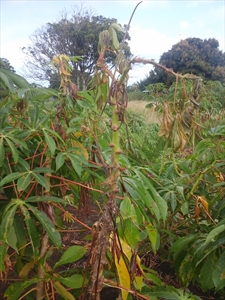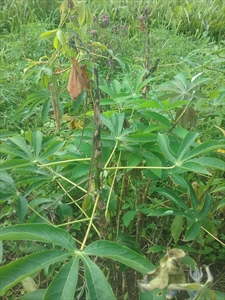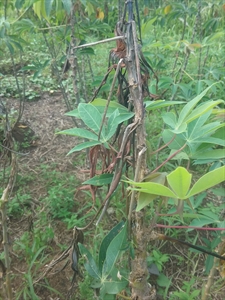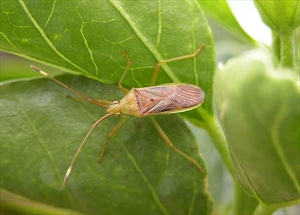Cassava shoot dieback, coconut premature nut fall
Pacific Pests, Pathogens, Weeds & Pesticides - Online edition
Pacific Pests, Pathogens, Weeds & Pesticides
Cassava Amblypelta dieback (019)
Amblypelta species. The species on cassava has not been determined.
Southeast Asia (Singapore), Oceania. Amplypelta cocophaga is recorded only from Fiji, Papua New Guinea, Solomon Islands. There are several other species that occur in Australia, Indonesia, New Caledonia and Vanuatu.
Amplypelta cocophaga is recorded from more than 40 plant species belonging to 30 plant families. It is a pest of Eucalyptus deglupta (and Eucalyptus terecornis and Eucalyptus urophylla) causing shoot-tip wilt and dieback, nut fall of coconut, and pod spots and distortions on cocoa. It is presumed that it is the same species that attacks cassava. Papaya, mango, melon and passionfruit are also attacked. Many of the same plants are also attacked by Amplypelta lutescens lutescens in Australia, which has over 100 hosts.
It is possible that Amblypelta injects a toxin as it feeds. Young fruit of coconuts (buttons or nuts) fall, Eucalyptus and cassava shoots wilt and die, and cankers form on the stems (Photos 3-6), and on cocoa, brown spots occur, beginning on the young pods, which become distorted as they grow.
Fruit and nut drop also results on lichi, longans and macadamia when attacked by Amblypelta nitida and Amblypelta lutescens lutescens in Australia.
The adult Amplypelta is about 20 mm long, the legs are pale green, while the wings are pale-brown (Photo 7). Females lay eggs on or near the host plant, usually on the lower surface of leaves. The eggs are green when laid, becoming red as they mature. Nymphs hatch a few days later. They are dark brown with long legs and antennae (Photo 8); the later stages look like adults without wings. Nymphs feed in the same way as adults, and on the same plants, using needle-like mouthparts. It is not known if nymphs inject toxic chemicals, but it is likely. Wings develop when nymphs become adult, 3-4 weeks after emerging from the egg.
The adults are active flyers and spread is likely on the wing.
It has been noticed that populations increase when forests are cleared, and the land is planted to crops or weeds, for instance Eucalyptus and Merremia.
Early or premature nut fall of coconuts in Solomon Islands has been a major problem in some parts of the country since the 1930s, and has been investigated by a number of entomologists. The islands of Guadalcanal, Malaita and Nggela are those most affected. Loss of coconuts was estimated to be between 10 and 20%, but on individual farms on Malaita and Nggela losses were much higher. It is difficult to be accurate as nut fall is patchy, depending on the distribution of various ant species and their interaction with Amblypelta . Also, coconut has a natural fruit drop of over 60%.
Another problem occurred in the 1980s. Amblypelta dieback was seen on Eucalyptus, threatening the success of forest replanting schemes on Kolombangara, in particular. Amblypelta caused death of the leading shoot. Side shoots developed, but these, too, were attacked and the trees became hedge-like. The result was that Eucalyptus deglupta was abandoned as a plantation species. More recently, a severe outbreak of Amblypelta was recorded on cassava in north Malaita and in the southern highlands of Papua New Guinea causing dieback and canker.
The species in Australia (Amblypelta nitida and Amblypelta lutescens lutescens) cause major problems on cashew, litchi and macadamia, feeding on those and many other tropical and subtropical crops, and causing premature fruit or nut fall and stunted plant growth.
Look for a bug with a pale green body, long legs, and pale brown wings. Look for the very long needle-like sucking mouthparts, almost as long as its body. The young bugs look like the adults, except they are smaller and wingless. Look for wilting shoots of cassava and Eucalyptus, and look for stem cankers. On coconuts, look for palms that shed large numbers of young nuts.
NATURAL ENEMIES
Most studies have been made in Solomon Islands. In 1937, egg parasites were collected in Indonesia and released in Solomon Islands against Amplypelta cocophaga. However, these did not control the pest. Later, a tachnid fly (Pentatomophaga bicincta) was introduced from Queensland, but this, too, was unsuccessful. A braconid wasp was found on Kolombangara island infecting late stage nymphs, but again, it did not lead to success. Assassin bugs and spiders are natural enemies of Amblypelta species in Australia, as are egg parasitoids of Amblypelta lutescens lutescens in the Northern Territory, but none appeared to be potential candidates for biological control in Solomon Islands.
Amblypelta is found at low numbers on coconuts and probably other hosts. The damage caused by one adult is significant, so it is unlikely that parasites would reduce numbers enough to prevent economic losses.
BIOLOGICAL CONTROL - ANTS
Attempts over many years to control premature nut fall of coconuts have tried to encourage some ant species whilst removing others. Mostly, this has meant removing Pheidole megacephala and Iridomyrmex cordatus and encouraging Oecophylla smaragdina. The idea is to have ant species that discourage Amblypelta from feeding on the young nuts. Oecophylla invades the palm in search of food and at the same time disturbs Amblypelta from feeding.
Removal of Pheidole using herbicide and insecticide applied to the base of the trunk is possible. Once removed, soursop trees are planted among the coconuts, the fruits of which readily become colonised by mealybugs, which are 'farmed' by Oecophylla for their honeydew. The success of this strategy was patchy, however, as the ant populations keep changing. Also, removal of Iridomyrmex is difficult as it makes nests in the crown of the palm, not in the ground.
In more recent years, a fire ant, Wasmannia auropuntata, has become established throughout Solomon Islands after an accidental introduction from overseas. This ant is capable of protecting palms against Amblypelta as well as displacing Pheidole and Iridomyrmex. It is, however, a fire ant and it is unpleasant working in coconut and cocoa plantations where it is present.
CULTURAL CONTROL
Before planting:
- Cultural control has been attempted in Solomon Islands in Eucalyptus plantations by cutting back interrow vegetation to reduce breeding sites, compared to planting in rows 2 m wide through the forest. The level of damage showed no difference.
During growth:
- Handpick the insects on cassava. To be successful, it has to be done over a large area, and that means collaboration between the farmers. If tried, it is best to do it in the early morning or late evening when the insects are less active.
CHEMICAL CONTROL
On cassava, try sprays of derris or pyrethrum (see Fact Sheet no. 56). If a synthetic product is needed, use pyrethroids or malathion.
On coconuts, a number of insecticides applied as sprays or as trunk injections from different chemical groups have been tested against premature nut fall. Some were effective; however, the height of coconut palms prohibits easy application, and it is unlikely that such treatments are economic. To be effective, they need to be applied frequently, perhaps 8-10 times a year.
Note, there is a pheromone, a synthetic lure, based on compounds produced by male Amblypelta lutescens lutescens, and incorporated into a trap. It is unlikely that it will attack other Amblypelta species, but this should be tested.
--------------------
Note, derris (Derris species) contains rotenone, an insecticide, often used as a fish poison; it should be used with caution. The commercial derris insecticide is made from Derris elliptica.
____________________
When using a pesticide, always wear protective clothing and follow the instructions on the product label, such as dosage, timing of application, and pre-harvest interval. Recommendations will vary with the crop and system of cultivation. Expert advice on the most appropriate pesticides to use should always be sought from local agricultural authorities.
AUTHORS Helen Tsatsia & Grahame Jackson
Information from CABI (2017) Amblypelta cocophaga (coconut bug). Crop Protection Compendium. (www.cabi.org/cpc). Photos 1&2 Brisbane Insects and Spiders website. (http://www.brisbaneinsects.com/brisbane_coreidbugs/GreenCoonBugs.htm). Photo 5 Michael Atuai. PNG LNG Livelihood Restoration Team.
Produced with support from the Australian Centre for International Agricultural Research under project PC/2010/090: Strengthening integrated crop management research in the Pacific Islands in support of sustainable intensification of high-value crop production, implemented by the University of Queensland and the Secretariat of the Pacific Community.











